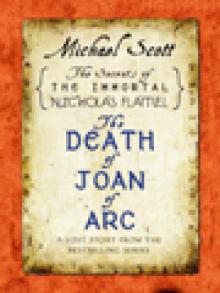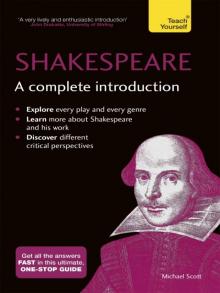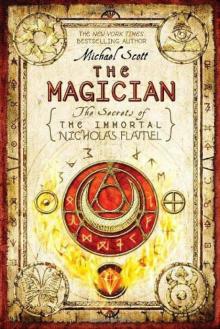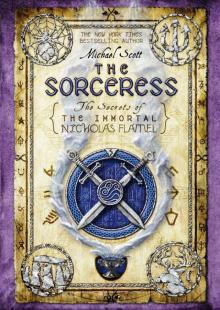- Home
- Michael Scott
Shakespeare- a Complete Introduction
Shakespeare- a Complete Introduction Read online
Shakespeare:
A Complete Introduction
Michael Scott
To the family
Acknowledgements
This book could not have been written, produced or published without the help and support of my wife, Eirlys, who worked tirelessly on it with me from its inception, but who sadly died before its publication. My thanks are incalculable, my love immeasurable. She wanted the book to be dedicated ‘to the family’. I wish it also to serve as a tribute to her memory and to her love for us all.
My thanks to Professor John Drakakis, friend and colleague, who has diligently read through the typescript, making suggestions and comments which I have invariably included. Thanks also to Terry Hands, former Artistic Director of the Royal Shakespeare Company and subsequently of Clwyd Theatre Cymru, a good friend with whom I’ve discussed elements of this book and who has inspired generations of theatregoers.
I am grateful to my publisher and editor, Victoria Roddam, for her professionalism, guidance and timely notes of encouragement through the writing period, and to my project manager, Sarah Chapman, and my literary agent, Charlotte Howard at Fox and Howard Ltd, for their advice and support.
I owe a debt of gratitude to all my teachers and colleagues at the various universities at which I’ve studied or taught and to those teachers and members of my family who in my schooldays gave me my first insight into the joy of Shakespearean performance and study. Too many are, sadly, now long gone but will never be forgotten. Thanks also to Medwin Hughes, Vice Chancellor of University of Wales Trinity St David for his support and encouragement. I am grateful as always to my daughters, sons-in-law and grandchildren for the joy they give us as a family, which encourages the writing.
Finally, I acknowledge with gratitude all those writers and scholars referenced and/or quoted in this book and, of course, the students I have been privileged to teach, both in the UK and abroad.
Contents
Preface
1 Releasing Shakespeare
Shakespeare the entertainer
Shakespeare the businessman
Shakespeare through time
2 The framing of Shakespearean comedy: The Comedy of Errors (1594)
The plot of the play
The structure of the play
3 Critical perspectives 1: Neoclassical and Romantic approaches
The seventeenth century
The eighteenth century
Romanticism
4 A Midsummer Night’s Dream (1595–6) and Romeo and Juliet (1595–6)
A Midsummer Night’s Dream
Romeo and Juliet
From dream to nightmare
5 Shakespeare’s poetic and theatrical language
The iambic pentameter and the sonnet form
A muse of fire
Body and stage language
Forms of communication
Music and song
The perils of over-analysis
6 Love’s Labour’s Lost (1595) and The Two Gentlemen of Verona (1591–2)
Understanding the plays’ structure
Love’s Labour’s Lost
The Two Gentlemen of Verona
7 Living up to its title: As You Like It (1599–1600)
Troubled times
Sex and sexual titillation
In the Forest of Arden
The structure of the play
8 Twelfth Night; or, What You Will (1601)
Carpe diem
‘What if?’
Creating and animating a tableau
‘This is I’
‘That that is, is’
9 Critical perspectives 2: Theatrical Influences on Shakespeare in performance and interpretation
The empty space
Acting style
Film and television
The multi-conscious apprehension of the audience
Recreating the Shakespearean stage
10 Much Ado About Nothing (1598–9) and The Taming of the Shrew (1589–92?)
Much Ado About Nothing
The Taming of the Shrew
11 The Merchant of Venice (1596–8)
Confronting or pandering to anti-Semitic prejudices?
Flesh and blood
The Christian context
The mercantile currency
Deception and structure
12 Critical perspectives 3: Reading history, writing history and the English history plays
The Elizabethan fashion for history plays
History or tragedy?
Critical questioning
Sharp diffractions of light in Shakespearean studies
History and politics
Self-fashioning
13 The English history plays 1: The Henry VI plays (1591–2); Richard III (1592–4); King John (1595–7)
King Henry VI parts 1-3
Counterpointing and juxtapositioning
Richard III
King John
14 The English history plays 2: Richard II (1595–6)
The anointed king
Queen Elizabeth and Shakespeare’s Richard II
15 The English history plays 3, plus a comedy: 1 Henry IV (1596–7); 2 Henry IV (1597–8); Henry V (1599); and The Merry Wives of Windsor (1597–1601)
The Henry IV plays
Henry V
The Merry Wives of Windsor
16 Critical perspectives 4: Tragedy – some modern critical challenges; Titus Andronicus (1591–2)
Aristotle
The influence of A. C. Bradley
Text and performance
Meaning by Shakespeare
The individual and society
A cruel play for cruel ages: Titus Andronicus
17 Hamlet, Prince of Denmark (1600–1601)
The structure of the play
Memory and remembrance
Carnal sin
To be, or not to be
Renaissance humanism, political pragmatism and the theatre
18 Othello (1604)
Othello’s credulity
Stereotypes
Othello the outsider
Craftsmanship
Iago’s motivation
Truth and falsehood
Who is the protagonist?
19 King Lear (1605–6)
Structure and emblem
The test
Telling the truth
Goneril and Regan
Parallel plots
The heath
Interactive narrative
Questions of identity
The recognition scenes
20 Macbeth (1606)
What is a traitor?
Macbeth and interpretation
Hell’s gate
Temptation and conscience
‘Unsex me here’
Consequences
Signifying nothing
21 Critical perspectives 5: Searching for and interpreting the text
‘Good’ and ‘bad’ quartos and the First Folio
Different kinds of Hamlet
Original performance
Modern adaptations
Editorial decisions
Aligning plays with events
Nostalgia
Interpretation and performance
22 Greeks and Romans 1: Timon of Athens (1605) and Troilus and Cressida (1601–2)
Timon of Athens
Troilus and Cressida
23 Greeks and Romans 2: Julius Caesar (1599); Antony and Cleopatra (1606–7); Coriolanus (1608)
The structure of the plays
Merging stage and audience
Elizabethan contemporary issues
Manipulation of perception
The domestic and the pu
blic
The personal and the political
Challenging the audience
24 Critical perspectives 6: Some ‘isms’; a glossary; and selected biographies
Some definitions of ‘isms’
Glossary
Selected recent biographies
25 All’s Well That Ends Well (1605) and Measure for Measure (1604)
All’s Well That Ends Well
Measure for Measure
26 Cymbeline (1609–10) and a note on the poems
The genre debate
Provenance
Structural convention and innovation
The dirge for Fidele
Shakespeare’s poems
27 The Tempest (1611) and the collaborative plays: Henry VIII (1613); The Two Noble Kinsmen (1613–4); Pericles (1608); and The Shakespeare Apocrypha
Henry VIII
The Two Noble Kinsmen
Cardenio/Double Falsehood (?)
The Shakespeare Apocrypha
Pericles, Prince of Tyre
The Tempest
28 The Winter’s Tale (1610–11)
An ‘improbable fiction’
The impact of history on the play
Time
Spring
The art of grafting
Recognition
Autolycus
The theatrical wonder
Conclusion
Appendices
1 Dates of Shakespeare’s works
2 Some key dates, 1485–1633
3 The English monarchs, 1154–1649
4 Bibliography and further reading
Preface
Shakespeare wrote for everyone, whoever they were, from Queen or King to the most menial, and all came to see the plays. He is as comprehensive in his entertainment as he is in his audiences. For years, certain factions in society have tried to claim him for themselves and in so doing have deterred others, perhaps even you, from appreciating and enjoying his work. This book wishes to set him free for everyone to enjoy. It aims to introduce and explain the plays by looking at how they work, taking you on a journey through the genres of comedy, history and tragedy. It is the process of this journey, with its various landmarks, which is the book’s purpose.
We will also consider various critical perspectives that will help you clarify various movements or issues concerning Shakespeare’s work that we will meet along the way. Broad definitions of various critical movements, for example, can be found in Chapter 24. Obviously, as with any guide, I have to be selective. Each of Shakespeare’s plays is mentioned but we will spend more time discussing the best known and popular of the plays. Nevertheless, even plays in which Shakespeare may have had only the briefest creative and collaborative interest as a writer, get at least a mention, as do the poems, although I do not dwell on them in any detail.
There are plenty of good biographies of Shakespeare, and I spend a little time identifying some of the more recent ones but, throughout our journey, aspects of his life are referenced in the discussion. The book follows a logical framework, on which I comment in the conclusion, but I’ve taken care, I hope, to enable you to dip in and out of various chapters as you wish and to provide you with a wide range of references.
Hodder & Stoughton invited me to write this book following the publication of Shakespeare’s Comedies (2014) and Shakespeare’s Tragedies (2015), which I wrote for its All That Matters series. I draw on material from those books in some of the chapters. That being said, let’s ‘stiffen the sinews’ and begin.
Michael Scott
A NOTE ON THE REFERENCES
Unless otherwise stated, the text used for all quotations and references to acts, scenes and lines is The Arden Shakespeare Complete Works edited by Richard Proudfoot, Ann Thompson and David Scott Kastan, reissued edition 2011, paperback (London: Bloomsbury Methuen Drama).
1
Releasing Shakespeare
William Shakespeare has been hailed as one of the greatest thinkers of all time, one of the world’s finest artists, poets and dramatists. His plays are discussed in the context of their language, philosophy and ‘meaning’. Nowadays people study them and are assessed on his work in examinations. So intense has the Shakespeare ‘industry’ become that, in any single year, there are probably more words written about him or spoken of him than he wrote himself. He is a complex phenomenon that can cause us problems as we approach his work, whether on the page or the stage.
When we put this prodigious reputation together with the distance of four hundred years since Shakespeare died, we need to remember that there have been major changes in language, social values and perceptions. The medium of poetry in which much of the drama is written reflects the verbally dominant styles of communication and entertainment of his time that have become primarily visual today. In view of the vast amount of scholarship about the man and his work and an apparent elitist culture that has grown up around him, it is no wonder that some people approach his plays with trepidation.
Shakespeare the entertainer
Shakespeare was in the entertainment business. He made his living mainly from writing and acting in plays. He was so successful that he became a ‘sharer’ in his company, the Lord Chamberlain’s Men, and in their theatre, the Globe. The company name indicated that the Lord Chamberlain was the patron of the company. Without having a patron it was against the law to act in plays professionally, but this did not mean that the Lord Chamberlain actually subsidized the company. Through his name the actors were protected; without it they could have been prosecuted as vagabonds and vagrants.
‘…all Fencers Bearewardes Comon Players in Enterludes & Minstrels, not belonging to any Baron of this Realme or towardes any other honourable Personage of greater Degeree; all Juglers Pedlars Tynkers and Petye Chapmen;…[who] shall wander abroade and have not Lycense of two Justices of the Peace at the least,…shal bee taken adjudged and deemed Roges Vacaboundes and Sturdy Beggers.’
Act for the Punishment of Vagabonds 1572 (quoted in Gurr, A. [1970: 19], The Shakespearean Stage, 1574–1642. Cambridge: Cambridge University Press
The Globe Theatre was not the first theatre where the Lord Chamberlain’s Men acted or for which Shakespeare first wrote plays; that playhouse was ‘The Theatre’, situated north of the city of London. The lease for that playhouse ran out in 1597, so for the following year the company played at the neighbouring theatre, the Curtain, before moving to the Globe, which opened in 1599. The actors had to run their theatre and company as a commercial concern. Later, Shakespeare took a business interest in a further smaller indoor theatre, the Blackfriars, where the company could perform in winter. After the accession in 1603 of James VI of Scotland to the English throne as James I, the King became the patron of the company, which then became known as the King’s Men.
The Red Lion (1567) in Whitechapel was probably the first public theatre in London. In 1576 it was replaced by ‘The Theatre’, built by James Burbage in Shoreditch just outside the city walls. Burbage had been a carpenter and in 1575 had worked at Kenilworth Castle on the creation of the stage for the entertainment planned for the visit of Queen Elizabeth I to the Earl of Leicester, who owned the castle. Kenilworth was not far from Stratford-upon-Avon where Shakespeare lived. The Queen’s visit was a great occasion for the locality and occurred when Shakespeare was just 11 years old. We can only speculate about whether the boy went to the castle in the hope of seeing the Queen or whether he heard talk of it. Leicester entertained Elizabeth for 19 days, from 9 to 27 July. We know also that travelling players regularly performed in Stratford during Shakespeare’s childhood. There are, of course, no records of Shakespeare’s engagement with them but entertainment appears to have got into his blood from somewhere.
Key idea
Shakespeare’s works are easier to enjoy and to put into context if he is freed from the carbuncles of history and cultural elitism that have grown up around him. We may then get back to the purpose of the plays – to attract people from all strata of societ
y to what is popular entertainment.
There is much speculation about Shakespeare’s life before he arrived in London in the early 1590s, when he is first mentioned as an actor and a writer. We will come to that speculation later but it is held that in 1594 a playwright, Robert Greene, reportedly on his deathbed, complained that Shakespeare was taking and using the work of other dramatists to make his way in the theatre. Greene, apparently out of resentment, calls him an ‘upstart Crow’. Whether it was Greene or another writer – for example Thomas Nashe or Henry Chettle who wrote the Groatsworth of Wit but published it under Greene’s name – is a matter for debate. (See, for example, Katherine Duncan-Jones [2010: 48–56].) It is said that Greene died from ‘a surfeit of Rhenish wine and pickled herring’!
‘…trust them not: for there is an upstart Crow, beautified with our feathers, that with his Tiger’s heart wrapped in a Player’s hide, supposes he is as well able to bombast out a blank verse as the best of you: and, being an absolute Iohannes fac totum, is in his own conceit the only Shake-scene in a country.’
Greene’s Groatsworth of Wit Bought with a Million of Repentance, 1592
Whoever made the ‘upstart Crow’ accusation, it’s apparent just from looking at Shakespeare’s plays and consulting his sources that he adapted and rewrote some known plays and to great effect, since it appears that he was making them more popular and enduring with his audiences.
Spotlight
For the majority of his plays throughout his career, Shakespeare used known stories, plays and other sources to create his dramas, and to bring people into the theatre to entertain them and to make money for his company and for himself.
Shakespeare the businessman
As a ‘sharer’ in the company, Shakespeare had part-ownership of the company and the properties, the scripts and the costumes. It was what we might regard as a communal business with the risks shared, at first, between eight and, later, 12 fellow members of the company. Their business manager was John Heminges, one of the two men who later published the First Folio of Shakespeare’s works in 1623. When Shakespeare retired, in 1613 or thereabouts, he was quite a wealthy man, owning handsome properties in Stratford and London and some land. He was also involved in a controversy over a proposal to enclose some of this land, which would have allowed him to make more money but at the expense of poorer people. As it happened, the particular proposal was not successful. We know that he also loaned money and that he purchased a large house in London, which he rented out.

 The Warlock
The Warlock The Necromancer
The Necromancer Tom Cringle's Log
Tom Cringle's Log Delphi
Delphi The Magician
The Magician La mort de Jeanne d'Arc (trad. privee)
La mort de Jeanne d'Arc (trad. privee) Magic and Myth
Magic and Myth The Death of Joan of Arc
The Death of Joan of Arc Saint Patrick
Saint Patrick Aoife and Scathach, Shadow Twins
Aoife and Scathach, Shadow Twins Machiavelli
Machiavelli The Ballad of Black Hawk and Billy the Kid
The Ballad of Black Hawk and Billy the Kid The Sorceress
The Sorceress Nicholas and the Krampus
Nicholas and the Krampus The King of the Birds
The King of the Birds Nicholas Flamel 1 - The Alchemyst sotinf-1
Nicholas Flamel 1 - The Alchemyst sotinf-1 Shakespeare- a Complete Introduction
Shakespeare- a Complete Introduction 06 The Enchantress
06 The Enchantress 05 The Warlock
05 The Warlock The Nameless City
The Nameless City The Necromancer sotinf-4
The Necromancer sotinf-4 Mirror Image
Mirror Image Nicholas Flamel 2 - The Magician sotinf-2
Nicholas Flamel 2 - The Magician sotinf-2 The Sorceress sotinf-3
The Sorceress sotinf-3